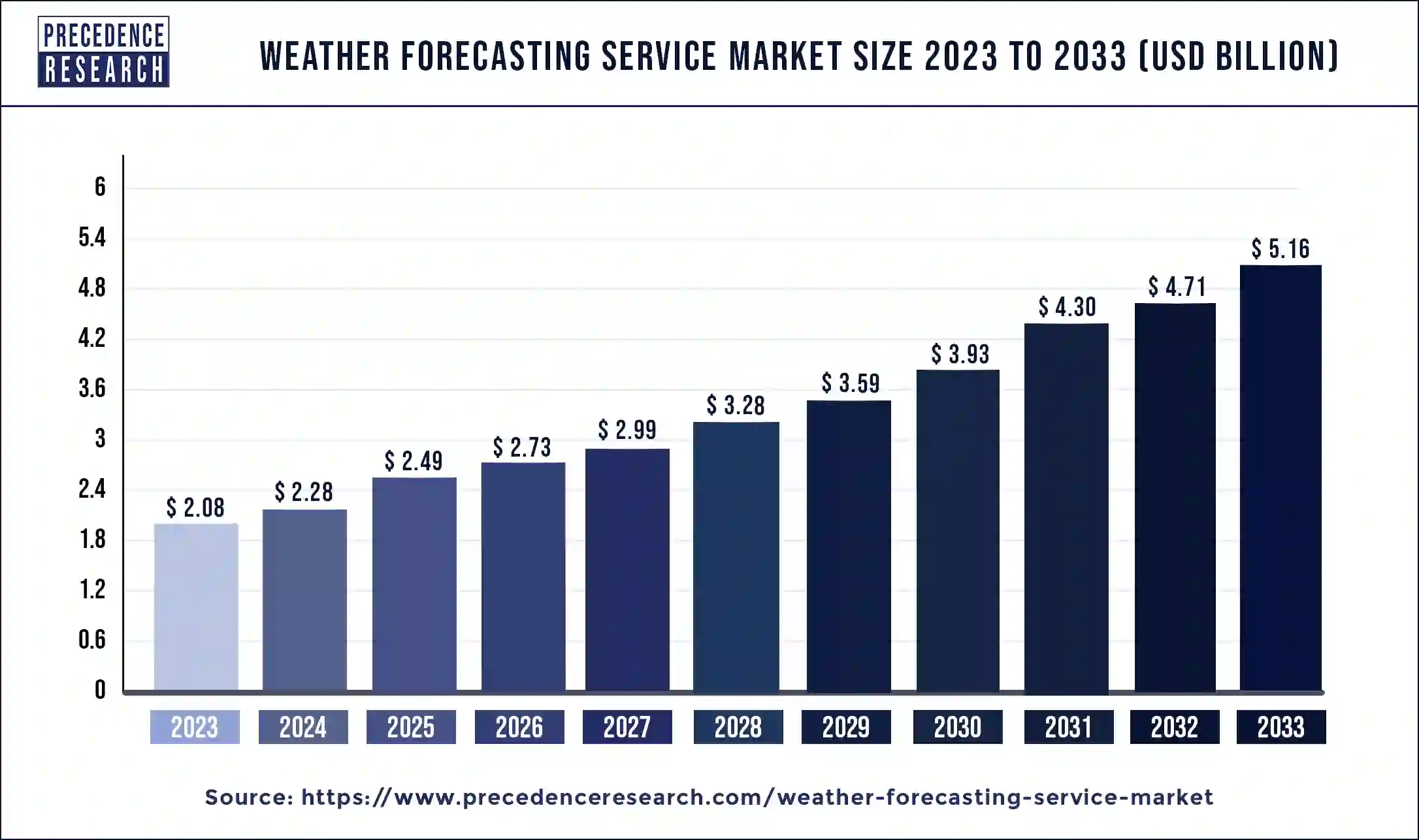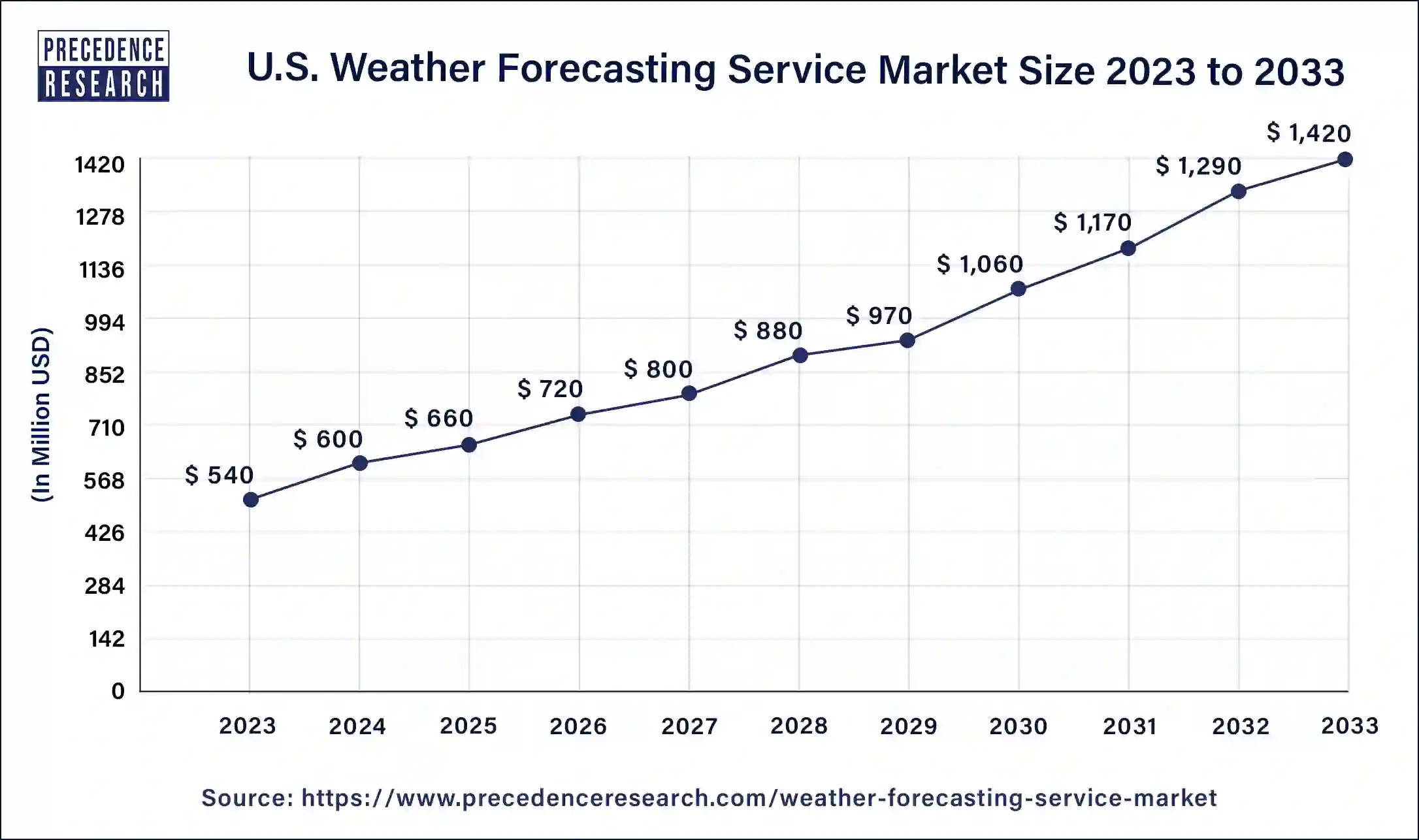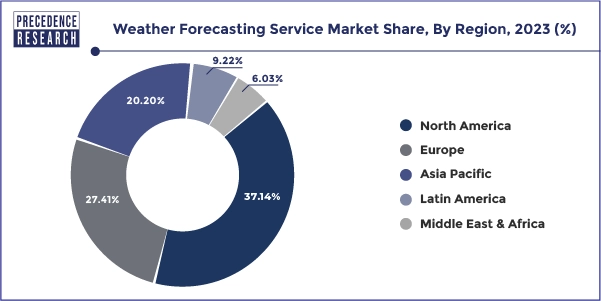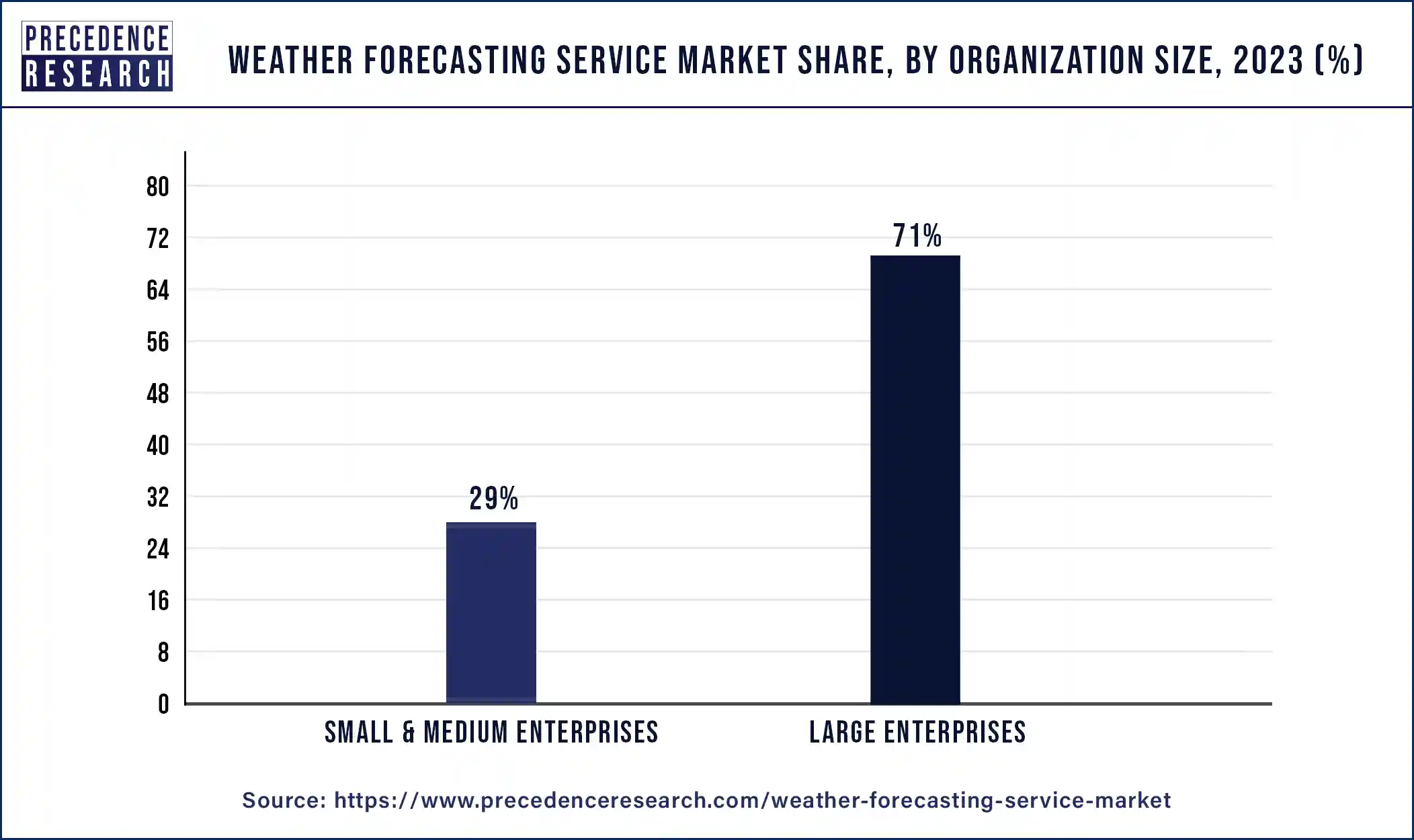December 2024
Weather Forecasting Service Market (By Industry: Transportation, Aviation, Energy & Utilities, Banking Financial Services & Insurance (BFSI), Agriculture, Media, Manufacturing, Retail, Others; By Organization Size: Large Enterprises, Small & Medium Enterprises; By Purpose: Operational Efficiency, Safety, Others; By Type: Nowcasting, Short-range, Medium-range, Long-range) - Global Industry Analysis, Size, Share, Growth, Trends, Regional Outlook, and Forecast 2024-2033
The global weather forecasting services market size was USD 2.08 billion in 2023, accounted for USD 2.28 billion in 2024, and is expected to reach around USD 5.16 billion by 2033, expanding at a CAGR of 9.5% from 2024 to 2033.

The U.S. weather forecasting services market size was estimated at USD 540 million in 2023 and is predicted to be worth around USD 1,420 million by 2033, at a CAGR of 10% from 2024 to 2033.

In terms of volume, North America held the biggest market share in 2023 and is expected to have substantial increase over the next seven years. The majority of end-user sectors, such manufacturing and aviation, are dominant in nations like the USA and Canada. To reduce pollution, the area is placing more of an emphasis on alternative energy sources like solar. These are the elements that support the expansion of weather forecasting services.
Due to the rapidly expanding sectors in the region, especially the transportation sector, demand is coming from nations like India, China, Japan, and others in the Asia Pacific. For the most part, these businesses rely on weather forecasting to increase production and profitability. In India, agriculture is crucial to the country's economy. Agriculture is the industry for which weather forecasting is most well-known. The need for weather forecasting services is growing in Europe due to the rapid industrialization and expansion of the aviation and shipping sectors, which depend on ideal weather to increase production.

Market Overview
Applications of science and technology are used in weather forecasting services to forecast atmospheric conditions. Digital satellite photography, radar imaging, model data, and surface measurements can now anticipate weather conditions more precisely because to developments and advancements in forecasting software. Over the past several years, the market for weather forecasting services has experienced substantial growth. The market is fuelled by the increased need for weather forecasting services brought on by an expansion of the agricultural sector to fulfil the demands of an expanding population, the need to enhance aviation safety, and the uncertainty of rainfall.
In order to upgrade their infrastructure, transportation and logistics are increasingly using weather forecasting services, which is driving the industry. It is projected that the development of sophisticated radars, small satellites, big data analytics for weather forecasting, and the growth of the renewable energy sector would all lead to new market expansion opportunities. The complexity of weather prediction models and the dynamic characteristics of atmospheric factors, however, are some of the restrictions that are projected to hinder the market's growth.
Numerous companies that provide weather forecasting services cater their solutions to particular sectors' demands. Artificial intelligence (AI) and machine learning (ML)-related technological developments are anticipated to help boost the accuracy of weather predictions. Many players also provide data and analytics weather services to their customers, assisting them in risk mitigation and improving operations. For the purpose of producing incredibly precise weather forecasts, market participants are investing in technology and research such as automation and supercomputers.
Weather forecasting has long been a challenging but important aspect of human existence. Accurate weather forecasts are crucial for achieving the necessary performance and safety in a variety of industries, including agriculture, fisheries, and contemporary aircraft. Weather forecasting also aids in lowering overhead transport and logistics costs and preventing significant losses brought on by severe weather. Additionally, technical advancements in product offerings, an increase in the requirement to improve performance and operational efficiency, an increase in the use of complex data analysis models, and an expansion of application areas among end users all contribute to the market's growth.
Services for weather forecasting Safety concerns in the aviation, transportation, and end-use sectors are driving market expansion. Production of renewable energy stimulates market expansion. A personnel shortage and complicated weather forecasting techniques might impede industry expansion. The market for weather forecasting services will grow as a result of technological developments in computer systems and a booming transportation sector in emerging nations.
| Report Coverage | Details |
| Market Size in 2023 | USD 2.08 Billion |
| Market Size in 2024 | USD 2.28 Billion |
| Market Size by 2033 | USD 5.16 Billion |
| Growth Rate from 2024 to 2033 | CAGR of 9.5% |
| Base Year | 2023 |
| Forecast Period | 2024 to 2033 |
| Segments Covered | Industry, Organization Size, Purpose, and Type |
| Regions Covered | North America, Europe, Asia-Pacific, Latin America, and Middle East & Africa |
Increased complexity along with the lack of professional weather forecasting methods
Supercomputers boost computing power
Rising penetration of advanced technologies in weather forecasting service
In order to foresee harm from extreme occurrences and properly inform consumers about the anticipated damage due to severe weather conditions, the insurance industry employs weather forecasting services. Policyholders can start taking precautions to prevent weather-related damage when they are informed of an impending weather event. In a similar vein, insurers may allocate resources in advance of significant weather occurrences by using precise and timely meteorological data.
Profits in the agriculture sector of emerging nations are now heavily reliant on weather conditions. It is well knowledge that farmers without access to reliable insurance markets behave cautiously, making less investments in their operations and selecting crop combinations and cultivation methods that limit farm profit volatility at the penalty of lower predicted returns. Experts on climate change and decision-makers have known for a long time that the insurance sector has a sizable pool of necessary expertise. In addition to having in-depth understanding of extreme weather and the hazards it brings, the insurance sector is skilled at creating scenarios, modeling weather risk, and matching incentives to desired behavior.
During the projection period, the category of small and medium-sized businesses is expected to increase at the greatest CAGR. The development of weather forecasting services provides SMEs with chances to control weather-related hazards. It is anticipated that a number of SME-focused businesses, government programs, and weather forecasters would contribute to the expansion of the market for weather forecasting services.

The marine sector is utilizing the forecasts to maximize production and reduce hazards as the accuracy of weather forecasts rises, made possible by better technology and instruments. The Weather Company (US) has agreed to supply weather predictions to XShip (India), a worldwide maritime advisory service provider, so that it can determine the optimal routes for ships with 95% accuracy.
During the projected period, the segment with the second biggest market size is the short-range forecast type segment. The short-range segment is expected to grow at a CAGR of 6.8% from 2024 to 2033. Weather maps, satellite photos, weather balloon data, weather charts, and other ground-based data are all used to create short-range predictions. In addition to being utilized for aircraft and maritime navigation, it is also employed for weather prediction. This kind of prediction accomplishes its goal by providing details on the anticipated weather for the next several days, giving people enough time to prepare in the event of an emergency.
Fisheries and transportation are the industries that stand to gain the most from short-range forecasting. Both of these sectors depend on accurate weather forecasts for the next 48 hours to operate.
Market Segmentation
By Industry
By Organization Size
By Purpose
By Type
By Geography
For inquiries regarding discounts, bulk purchases, or customization requests, please contact us at sales@precedenceresearch.com
No cookie-cutter, only authentic analysis – take the 1st step to become a Precedence Research client
December 2024
December 2024
January 2025
March 2025